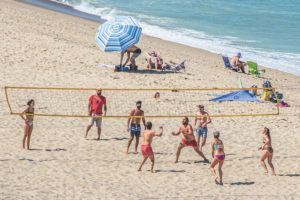
Many arriving on Outer Cape beaches this summer are bringing beach games with them — a reflection of people’s widespread but pent-up need to interact.
Several popular beach games are allowed under Massachusetts safety rules, given that players can maintain social distancing of six feet.
“No-contact ball games such as catch, Kadima (paddleball), Kan Jam and bocce can be allowed provided that social distancing can be maintained, and group size guidelines followed,” the standards state.
Every move in beach games is made a little more difficult because of playing on sand, so they’re great workouts, and playing well requires some athleticism. The main thing, this year, is to stay safe while playing. That used to mean sunscreen. Now, in addition, it means keeping hands sanitized and, above all, heeding the challenge of maintaining a reasonable distance between players. When that’s not easy, masks are a must.
Bocce
You’ll have to buy a set of bocce balls to play this one. The set comes with eight balls in four colors. There’s also one small white ball, which serves as a target. Bocce balls can be made of clay, metal, or plastic. While plastic balls might be too easily lifted by sea breezes, you might think twice about lugging metal ones down the dunes.
The game starts with someone throwing the small white ball in the sand. Players then take turns throwing their balls toward the white ball. The object is to get your ball(s) closest to the small white ball to earn points.
Cornhole
Cornhole is another throwing game that requires players to buy a set (though instructions on making one are out there, if you’re handy). The set comes with two wooden boards that stand up at an angle. Each board has a circular hole toward the top of it.
Position the boards some 20 feet apart, facing each other. The game is played two-on-two with two players standing behind one board and two players standing behind the other board so that your teammate is standing across from you.
Opposing teams toss four bean bags each toward the wooden board opposite them. The objective is to get your bean bags to land and stay on the wooden board (one point) or, better still, go in the hole (for three points).
Polish Horseshoes
This game requires a Frisbee, two poles or stakes, and two glass bottles. The poles are set some 20 feet across from each other, and a glass bottle placed on top of each. This time, teammates stand (six feet apart works), behind one of the poles.
The game starts with one player flinging a Frisbee toward the other team’s pole, trying to hit either the pole or the bottle itself. The receiving team must catch the Frisbee and the bottle, if it is knocked off the pole.
Points are scored when the receiving team misses the Frisbee or the bottle.
Games are typically played to 21. In some circles, a degree of difficulty is added when each player has a drink in one hand, making catching the Frisbee or bottle much harder.
Better Masked
Two no-contact ball games, volleyball and Spikeball, are popular on the beach these days. But playing safely takes more effort. Here’s where playing with masks on makes a difference.
Volleyball
Beach volleyball is typically played to a score of 21 with six people per team, arrayed six on one side of the net and six on the other. For most of the game, a six-foot — or bigger — distance between players is possible. The object is to hit the ball to the other team’s side, inbounds, where they’re not able to return it and it hits the ground. But beach players know that a good volley back and forth is as much fun as a killer spike that scores points.
Spikeball
This might be the fastest growing beach sport in the last decade. If you’ve seen kids hit a bright yellow ball back and forth on a circular net, then you’ve seen this game in action.
The game requires four players and a Spikeball set, sold at most sporting goods or beach-theme retail shops. Four players stand around the circular Spikeball net with teammates standing next to each other. The game starts when one person hits the rubber Spikeball onto the net to the opponent across from them. That’s the serve.
After the serve, the opponent must set up the ball to her teammate. Each team has three hits per side. If a team successfully hits the ball on the net with the other team unable to return it, that’s worth one point. Games are usually played to 21.
The game can become a free-for-all, as the ball can travel if hit on the net correctly, which sends opponents running in the sand to get it back into play.



